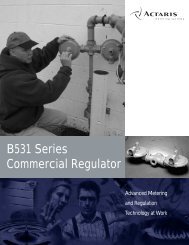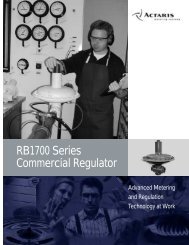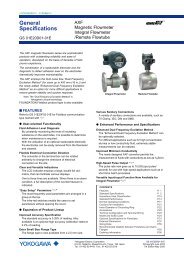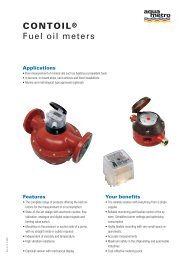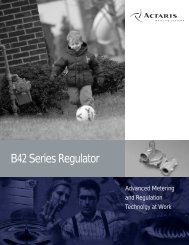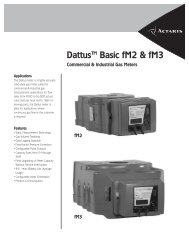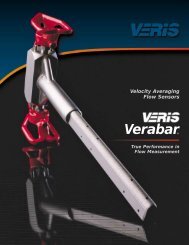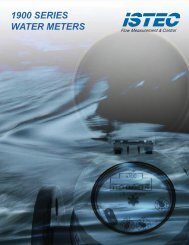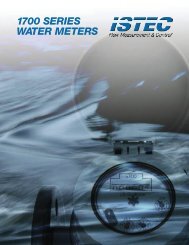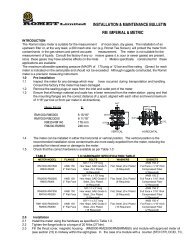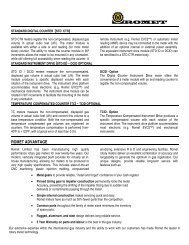User's Manual AXF Magnetic Flowmeter Integral ... - Yokogawa
User's Manual AXF Magnetic Flowmeter Integral ... - Yokogawa
User's Manual AXF Magnetic Flowmeter Integral ... - Yokogawa
Create successful ePaper yourself
Turn your PDF publications into a flip-book with our unique Google optimized e-Paper software.
3. INSTALLATION<br />
(4) Terminal Box Cover<br />
IMPORTANT<br />
As it is possible that the insulation will deteriorate,<br />
do not open the terminal box cover until it<br />
is time to wire it.<br />
(5) Long-term Non-use<br />
IMPORTANT<br />
It is not desirable to leave the flowmeter unused<br />
for a long term after installation. If this situation<br />
is unavoidable, take care of the flowmeter by<br />
observing the following.<br />
Figure 3.2.2<br />
Slanted<br />
Misaligned<br />
F0308.EPS<br />
Slanted and Misaligned <strong>Flowmeter</strong> Piping<br />
(2) Inside a newly installed pipeline, there may be<br />
some foreign substances such as residue from<br />
welding or wood chips. Remove them by flushing<br />
the piping before mounting the flowmeter. This<br />
prevents the lining from being damaged, as well as<br />
the occurrence of erroneous measured signals<br />
resulting from foreign substances passing through<br />
the flowtube during measurement.<br />
• Confirmation of sealing conditions for the<br />
flowmeter<br />
Confirm that the terminal box screw and wiring ports<br />
are well sealed. Equip the conduit piping with drain<br />
plugs or waterproof glands to prevent moisture or<br />
water from penetrating into the flowmeter through the<br />
conduit.<br />
• Regular inspections<br />
Inspect the sealing conditions as mentioned above, and<br />
the inside of the terminal box at least once a year.<br />
Also, due to rain, etc. when it is suspected that water<br />
may have penetrated into the inside flowmeter perform<br />
supplementary inspections.<br />
3.2.2 <strong>Flowmeter</strong> Piping<br />
CAUTION<br />
Misaligned or slanted piping can lead to leakage<br />
and damage to the flanges.<br />
(1) Correct any misaligned or slanted piping, and any<br />
gaps that may exist between mounting flanges<br />
before installing the flowmeter (refer to Figure<br />
3.2.2).<br />
3.3 Mounting Procedures<br />
NOTE<br />
• The tightening torque value to which gaskets<br />
must be tightened varies depending on the<br />
type and external dimensions of the lining and<br />
the gasket. In this section, the tables indicating<br />
tightening torque values include the corresponding<br />
gasket types. The internal diameters<br />
of the gaskets are close to those of the grounding<br />
rings.<br />
• For fluids capable of potentially permeating<br />
PFA linings (such as nitric acid, hydrofluoric<br />
acid, or sodium hydrate at high temperatures),<br />
different tightening torque values must be<br />
applied. The tables of these torque values is<br />
indicated in this section.<br />
• For replacement models for the earlier ADMAG<br />
or ADMAG AE, the tightening torque values in<br />
the tables can be applied if their process<br />
connections, the lining types, and the nominal<br />
sizes are the same.<br />
3.3.1 Nominal Diameter 2.5 mm (0.1<br />
in.) to 10 mm (0.4 in.), Union<br />
Joint Type<br />
Ceramics linings with diameters of 2.5 (0.1), 5 (0.2), or<br />
10 mm (0.4 in.) are connected using union joints. Weld<br />
or screw the connecting fittings in Table 3.3.1 onto the<br />
piping. The external dimensions of the fittings are<br />
shown in the table.<br />
3-4<br />
IM 01E20D01-01E




